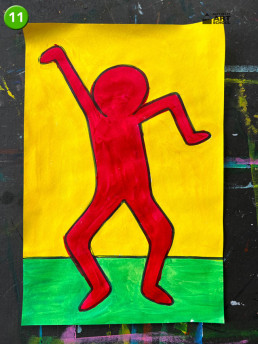NEW: Celebrating Our Differences
Intermediate Level
This lesson is inspired by the artworks of Keith Haring (1958 – 1990). Keith was an American artist who became famous for creating artworks that represented equality and the rights of people. His colourful simple figures showed how everyone is different.
Inspired by Keith, in this lesson we create an artwork of a simple, dancing figure to represent who we are. Our person represents how we are all different by showing the figure dancing or moving in different ways. We also share this message by creating our figure using many different colours. We are all different and that’s what is great!
Materials
- Lead pencils
- Scrap paper to practise
- White art paper
- Thick black markers
- Erasers
- Poster paints in your chosen colours. At least 3 colours.
- Paint brushes
- Paint tray
- Water container
- Paper kitchen towel to clean brushes
- Table cover or newspaper to protect your work area
- Paint shirt or apron
- Glue sticks
- Paper or cardboard for mounting
- Optional: Paint pens to add detail and contrasting lines.
Easy Peasy Tips:
- This artwork will only succeed if you practise a little first. The drawing of the figures can be a little tricky and the more you practise the more you will improve.
- When practising, try drawing your figure in different poses and see which one is your favourite.
- When drawing your figures, think about the basic parts of the human body and their size compared to other parts.
- For example:
- Your legs are approx. half of your body.
- Your arms and hands extend approx. half way down your thighs when standing up straight.
- Your foot is approx. the same length as your forearm.
For The Teacher:
- This lesson will need to be taught over two sessions to allow time for the paint to dry.
- Please select images of Keith Haring’s work before showing them to your class to ensure that they are appropriate for viewing in the classroom.
- The suggested image to display to your class is: Keith Haring – Untitled (Dancers) 1987
- Make sure you discuss with your class what they can see in the image and to talk about what it might represent or what message Keith Haring was trying to give the viewer.
Steps
- Practising: To begin the lesson, the first step is to practise drawing the figures. On a scrap piece of paper follow our steps to draw our figure as shown using a lead pencil. One you have done this, try to draw the figure again but this time in a different pose. Try to be creative as you can and to think about different moves you might make when dancing.
- You might want to use our figures shown here as inspiration to help get the proportions correct with your drawing.
- Drawing: To draw your figure, begin with the head. Imagine you are drawing part of an oval. Or a large letter “C” laying down.
- Next, draw the arms and hands. Start your arms right next to the head as shown. Try adding bends at your elbow and putting your hands in an interesting position. Remember to keep your design simple and to aim for not making it too skinny. We are not drawing stick figures! Use straight lines whenever possible and to keep the arms thick. Once you have drawn the arms, draw your torso. Remember to make your torso wider than your head.
- Now add the legs. Think about how your legs might bend when you dance. Make your legs thicker than your arms and remember the basic rule that your legs are about half the height of your whole body.
- Once you are happy with your basic design, now work on improving it. Use you pencil to sketch over your design. You may need to straighten lines or make features wider or thinner. Keep checking Keith’s designs and think to yourself, “What do I need to do to make my figure look more like one of Keith’s?” Once you have drawn several figures as practise, draw your final copy on your sheet of art paper. Remember to try and use the whole space so that your figure is nice and big.
- Once you have drawn your figure, carefully trace it using a thick, black marker. Don’t forget to also add a horizontal line behind your figure to represent the floor or ground. Once you have traced the figure use an eraser to remove as much of the pencil drawing as possible otherwise you will see it through the paint.
- Painting: Prepare your painting materials and workspace. The colours you choose are up to you but try and use bright colours that you think will look nice and stand out. One thing to think about is try to be careful not to choose colours that are too dark or you may not see the black lines or detail.
- Start with your lightest colour first. Here you can see us tracing our figure using long, smooth brushstrokes. To help with this, try adding a small amount of water to your paintbrush before dunking it in the paint. This will make your strokes smoother. The aim here is to paint as neatly as possible. Because our artwork has few details, any messy painting will really stand out!
- Keep painting until the whole space is filled with no white gaps.
- Then paint the remaining two spaces. Our whole painting only uses three colours but make sure you clean your brush really well between colours. A good tip is to dry your brush with paper kitchen towel once you have rinsed so that the water doesn’t discolour the paint. Once painted, set your artwork aside to dry.
- Tracing: Using a black marker, begin tracing back over your design. One you have done this, trace again but this time not over the line but next to it. The aim here is to make your lines thicker and thicker with each lap of the character. Try to make all your lines the same thickness.
- Once your tracing is complete, add the details. Keith Haring often would use words in his artworks, so add your name to show that the artwork represents you. Draw a rectangle around your name and then add small horizontal dashes on the ground as shown. Then think about the parts of your figure that may be moving. Think elbows, knees, hands or your head. Add three curved lines near each of these parts as shown. Don’t forget to make these details thicker as well.
- Optional: This step is optional if you have paint pens available. Paint pens are great for adding contrast to your paintings. Contrast means difference and in this case it means light and dark. Think about how you could use lighter colours as we have to add extra detail to your artwork. Just remember to keep it simple. Your artwork is now complete.
What do you like about your artwork? What would you do differently next time?
Other ideas:
- You could also paint this artwork using tempera disc paints.
- This lesson makes a great back to school artwork or when creating artworks about identity.
- Why not check out our other artworks inspired by artists that also allow us to represent ourselves in creative ways?

















